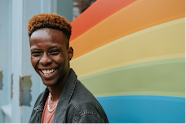 |
| Source: www.publicdomainvectors.org |
By Sam Piha
"Many LGBTQ+ people use labels to express who they are. These labels can help listeners like you and me understand who that person is and how they wish to identify." – It Gets Better Project
As the mainstream culture diversifies, our language is also evolving, which includes new terms related to sexual identity. It’s important that afterschool workers expand their vocabulary. Below are some LGBTQ+ terms and definitions. These definitions are not intended to label youth but rather to assist in understanding some frequently used terms. Youth may or may not use these terms to describe themselves.
 |
| Source: www.cem.org |
1. LGBTQ+: This stands for lesbian, gay, bisexual, transgender, queer (or sometimes questioning), and others. The "plus" represents other sexual identities including pansexual and Two-Spirit. The first four letters of the acronym have been used since the 1990s, but in recent years there has been an increased awareness of the need to be inclusive of other sexual identities to offer better representation.“Language is an extremely powerful tool. It allows us to generate ideas, share stories, and learn and grow from others. Whether spoken, signed, or written, all languages are constantly evolving, and, despite their imperfections, can help us better understand our world and communicate our perspective with others.” – It Gets Better Project
2. Bisexual: Bisexual indicates an attraction to all genders. The recognition of bisexual individuals is important, since there have been periods when people who identify as bi have been misunderstood as being gay. Bisexuality has included transgender, binary and nonbinary individuals since the release of the "Bisexual Manifesto" in 1990.
3. Transgender: Transgender is a term that indicates that a person's gender identity is different from the gender associated with the sex they were assigned at birth.
 |
| Source: www.pexels.com |
 |
| Source: www.namidanecounty.org |
7. Gender identity: A person’s deeply held sense or psychological knowledge of their own gender, regardless of the gender they were assigned at birth. Everyone has a gender identity.
8. Gender expression: This refers to the way a person expresses gender, such as clothing, hairstyles, activities, or mannerisms.
 |
| Source: www.pexels.com |
10. Genders & Sexualities Alliance (GSA): Genders & Sexualities Alliances, or GSAs for short, are student-run organizations that unite LGBTQ+ and allied youth to build community and organize around issues impacting them in their schools and communities. GSAs have evolved beyond their traditional role to serve as safe spaces for LGBTQ+ youth in middle schools and high schools and have emerged as vehicles for deep social change related to racial, gender, and educational justice.
11. Nonbinary: A person whose gender identity does not conform to the gender binary, which is the erroneous idea that only two distinct and opposite genders exist, male and female.
12. Pronoun: A word used in place of a name to refer to someone, often in relation to their gender. Gendered pronouns include she/her/hers and he/him/his. (For example, "She marched in the Pride Parade.") Gender-neutral pronouns include they/them/theirs, used in the singular. (For example, "They are a member of the GSA.") There are also neopronouns that include ze/zir/zirs, ey/em/eirs, and per/per/pers, as well as many others. To learn more, see Pronouns 101 from The Human Rights Campaign.
13. Afterschool programs: Community-based and school-based youth programs that are conducted before or after the school day and during the summer. These programs are also referred to as afterschool, out-of-school time (OST), youth programs or summer learning programs.
(Definitions 1-5 were drawn from an article by Kendra Cherry on www.verywellmind.com; definitions 7-9 were drawn from an article by the California Safe School Coalition); definition 10 is drawn from The Genders & Sexualities Alliance Network; definitions 11- 12 were drawn from the It Gets Better Project).
For more terms and definitions, see the LGBTQ+ Glossary from the It Gets Better Project.
To see additional tools to ensure a sense of safety for all youth, see our Youth Development Guide 2.0 here. Also available is a new briefing paper on supporting LGBTQ youth. Feel free to share these resources with your network.





No comments:
Post a Comment